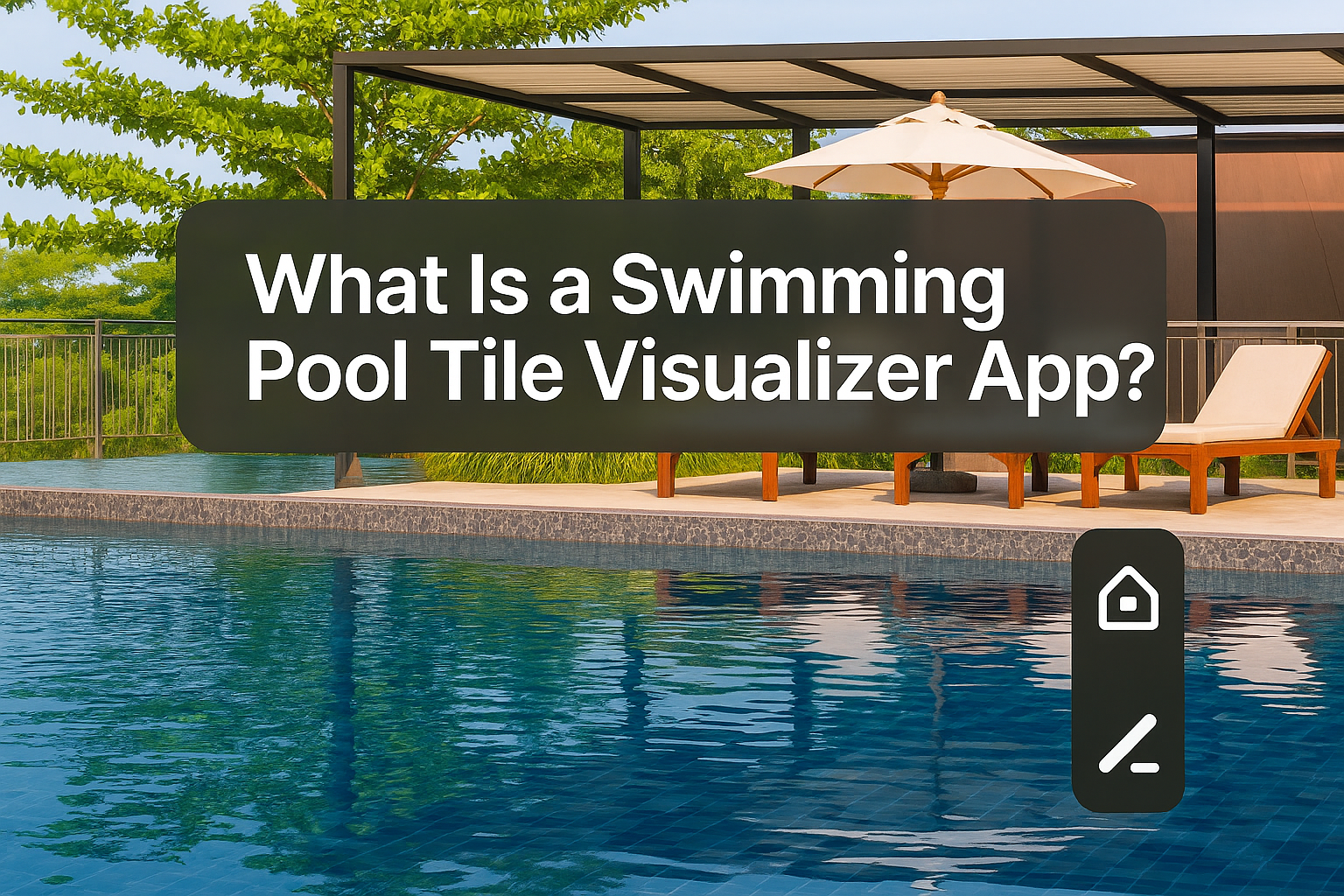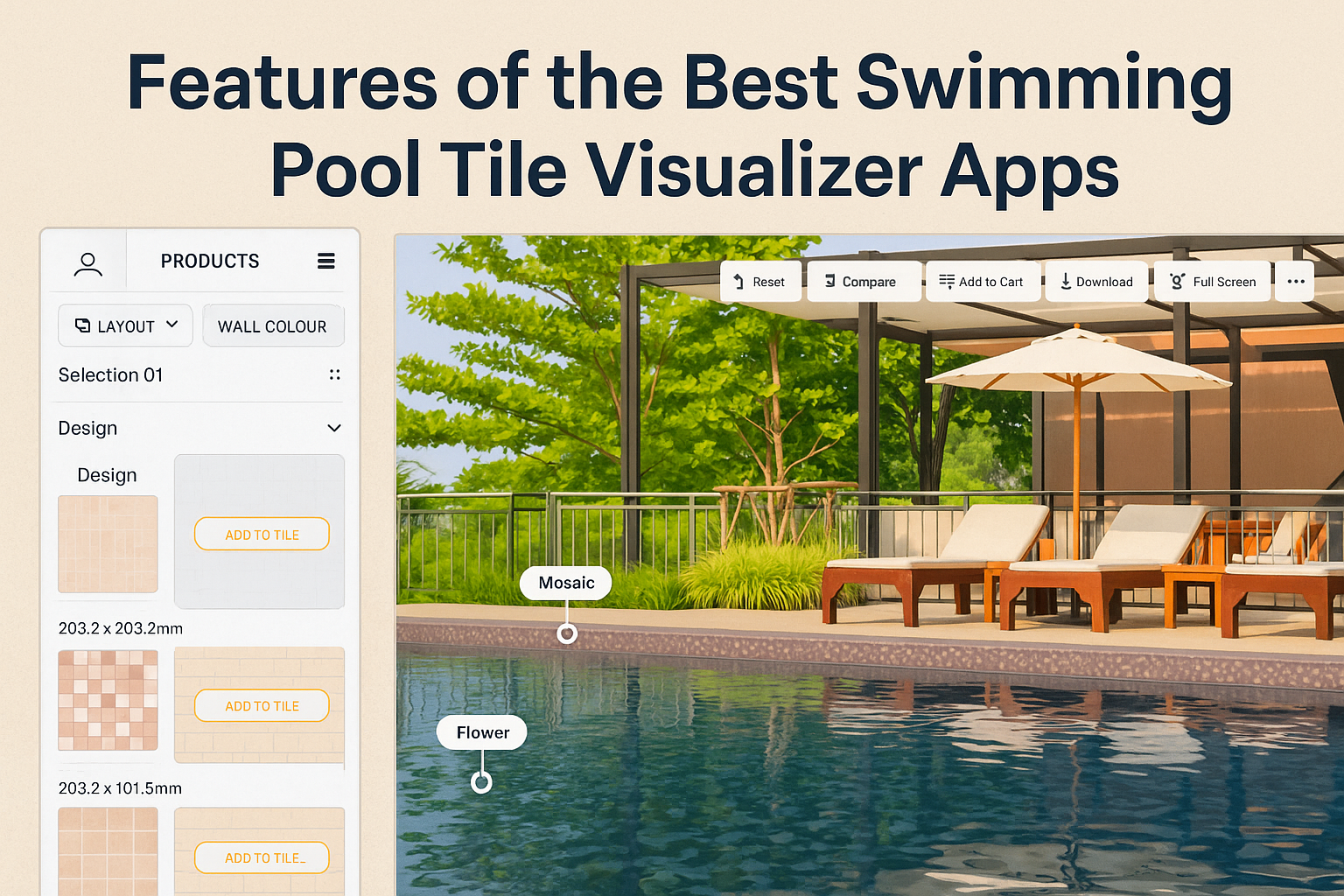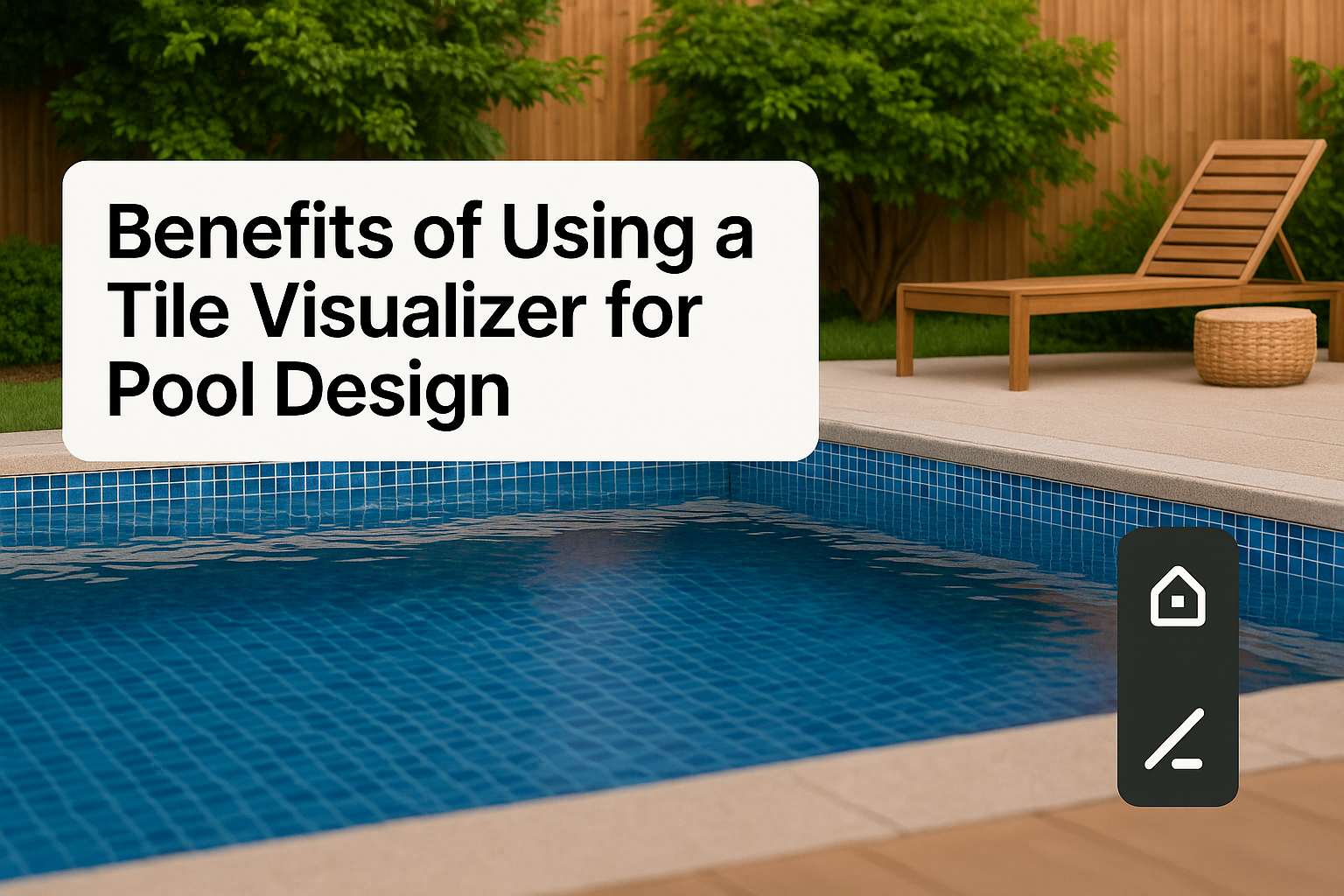Introduction
Designing a swimming pool is a significant investment that requires careful planning, especially when it comes to choosing the right tiles. The look and feel of your pool area depend heavily on tile selection, which impacts aesthetics, safety, and even maintenance. Traditionally, homeowners and designers relied on physical samples and imagination, which often led to unsatisfactory results. Today, technology has made it possible to preview tile designs digitally using advanced visualization apps. These tools help bridge the gap between concept and reality, allowing users to see how different tile styles would look in their actual swimming pool environment. This blog explores the features, benefits, and impact of using an app to visualize swimming pool tiles, focusing on innovation, functionality, and convenience.
1. Understanding Swimming Pool Tile Design
1.1 Types of Swimming Pool Tiles
Swimming pool tiles come in a variety of materials, each offering unique aesthetics and functional properties. The most common options include:
-
Glass tiles: Known for their vibrant colors and reflective surfaces, they are a favorite for modern and luxurious pool designs.
-
Ceramic tiles: Durable and cost-effective, ceramic tiles are widely used in both residential and commercial pools.
-
Stone tiles: Natural stones like travertine and slate offer a rustic and organic appearance, perfect for creating a natural oasis.
-
Mosaic tiles: These are small, often colorful tiles arranged in creative patterns, providing artistic flair to pool surfaces.
1.2 Common Design Patterns and Trends
Today’s pool design trends include geometric patterns, gradient blends, and nature-inspired textures. Designers are increasingly experimenting with mixes of matte and glossy finishes to add depth and sophistication. Mosaic medallions, border tiles, and custom logos are also gaining popularity among luxury pool owners.
1.3 Importance of Color, Texture, and Finish
Colors influence not only the pool’s visual appeal but also its temperature and depth perception. For instance, light blue tiles give the water a tropical, clean appearance, while darker tiles can make the pool look deeper and cooler. Textured finishes provide anti-slip benefits and contribute to safety, especially in poolside and shallow areas.
2. The Rise of Visualization Tools in the Home Improvement Sector
2.1 Growth of 3D Visualization Apps for Home Decor
Digital transformation has taken the home improvement industry by storm. With the rise of AR (Augmented Reality) and 3D rendering, consumers can now preview furnishings, paint colors, and flooring in real time. Apps that offer 3D visualization capabilities have become go-to tools for both professionals and DIY homeowners.
2.2 How Visualization Apps Help Decision-Making
These apps remove the guesswork from home design. By allowing users to see exactly how a product will look in a specific space, visualizer apps minimize the risk of buyer’s remorse. For swimming pool tiles, this means you can experiment with multiple options without any physical setup or demolition.
2.3 Case Study: Evolution from Catalog to Visualizer
In the past, tile selection meant flipping through static catalogs or visiting showrooms. This often resulted in a disconnect between expectation and reality. With visualizer apps, users can simulate how specific tiles will look when installed, all from the comfort of their home. It’s a shift from theoretical choice to experiential design.
3. What Is a Swimming Pool Tile Visualizer App?
3.1 Definition and Core Functionality
A swimming pool tile visualizer app is a digital platform that allows users to apply various tile designs to a virtual or real image of a swimming pool. These apps typically offer tools to choose, adjust, and preview different tiles on pool floors, walls, and surrounding areas.
3.2 Real-Time Previews with Uploaded Photos
One of the standout features of these apps is the ability to upload photos of your actual pool or construction site. The app overlays selected tiles on the image, giving you a real-time preview of how the design will appear once installed.
3.3 App Interface and User-Friendly Features
User-centric design is key to these apps. Most platforms feature intuitive interfaces, drag-and-drop tools, zoom functions, and customization options. Even non-tech-savvy users can easily navigate and visualize their pool tile preferences without professional help.
4. Features of the Best Swimming Pool Tile Visualizer Apps
4.1 Tile Rotation and Layout Customization
A top-notch swimming pool tile visualizer app should allow users to rotate tiles and experiment with different layout patterns. Whether you prefer a diagonal arrangement or a herringbone design, customization features help you visualize exactly how your ideas will look in practice.
4.2 Color Variation and Reflection Simulation
Advanced apps provide options to test out different colors and simulate the way light will reflect off various tile surfaces. This feature is especially useful for swimming pools, where sunlight and water can significantly alter the visual outcome.
4.3 Grout and Pattern Adjustment
Grout color plays a surprisingly important role in the final appearance of tiled surfaces. High-quality visualizer apps allow you to adjust grout color and width, helping you assess the contrast and harmony between tiles and grout in your pool area.
4.4 Compatibility with Smartphones and Tablets
Modern visualizer tools are mobile-friendly, ensuring that users can access and edit their designs on smartphones and tablets. This flexibility supports on-site decision-making and enhances convenience for contractors and clients alike.
5. Deep Dive: TilesDisplay as a Case Study
5.1 Overview of Tiles Display 3D Visualizer
TilesDisplay is a prominent Indian platform offering an innovative 3D tile visualizer app. It caters to homeowners, designers, and contractors who want to visualize tiles in different types of rooms, including swimming pools. The app allows users to upload custom spaces, select from various tile options, and generate previews in just a few steps.
5.2 Features Tailored for Swimming Pools
Though the platform broadly serves wall and floor visualization, its functionalities are easily adaptable to pool design. Users can choose glossy or matte tiles, mix multiple designs, rotate layouts, and even simulate lighting effects to understand how tiles will appear underwater.
5.3 User Testimonials and Reviews
TilesDisplay has garnered positive reviews from users across the globe. Testimonials mention ease of use, quick results, and the ability to experiment creatively without investing in physical samples. Customers from countries like the UK, India, and Malta have praised the app for saving both time and money in the design process.
6. Benefits of Using a Tile Visualizer for Pool Design
6.1 Saves Time and Cost During Planning
By enabling you to test designs virtually, visualizer apps eliminate the need for physical mockups or repeated site visits. This accelerates the decision-making process and reduces costs related to material wastage and design errors.
6.2 Boosts Design Confidence and Experimentation
Designing a swimming pool can be intimidating, especially for first-time homeowners. Visualization tools help you explore multiple ideas, compare them side-by-side, and finalize your favorite without second-guessing your choices.
6.3 Enhances Collaboration with Contractors
When your vision is clearly represented through digital previews, communication with architects, tile suppliers, and pool contractors becomes much easier. Everyone involved in the project can refer to the same visual reference, minimizing misunderstandings and errors during installation.
7. How to Use an App to Visualize Swimming Pool Tiles
7.1 Uploading Your Pool Design or Selecting Templates
Most tile visualizer apps offer two starting points: uploading a photo of your actual pool or choosing from pre-designed templates. If your pool is already built or under construction, uploading a current photo allows for more precise visualization. Alternatively, templates provide a generalized environment to experiment with designs.
7.2 Choosing Tiles and Experimenting with Layouts
Once your pool area is visible on the app, you can select tiles from a built-in catalog or upload custom designs. You can test various colors, materials, and patterns. Features like layout presets, tile mixing, and pattern orientation enable endless customization until you find the perfect combination.
7.3 Saving, Exporting, and Sharing Your Design
After finalizing the visual design, users can save the image for future reference. Many apps allow you to export previews as high-resolution images or PDF files. These designs can be shared with contractors, tile suppliers, or family members for approval and collaboration.
8. Integrating AR and AI in Tile Visualizer Apps
8.1 Augmented Reality for Immersive Design
Augmented Reality (AR) transforms how users interact with design tools. With AR, you can point your phone at your actual swimming pool and see the new tile design come to life in real time. This immersive experience gives a clearer sense of depth, texture, and lighting, making the design process highly interactive.
8.2 Artificial Intelligence for Smart Suggestions
AI-powered visualizer apps take customization a step further by offering intelligent tile recommendations based on your preferences, trends, and even pool dimensions. Some apps can automatically balance colors, identify symmetry, and suggest improvements that enhance both aesthetics and practicality.
8.3 Future Scope of Immersive Visualization
As technology advances, we can expect even more immersive features such as 360-degree walkthroughs, voice-controlled editing, and integration with smart devices. This would empower users to create pool designs that are not only beautiful but also future-ready.
9. Web Integration and E-commerce Capabilities
9.1 Integrating Tile Visualizers into Websites
Many tile companies and manufacturers now integrate visualizer tools directly into their websites. This allows customers to browse tiles, preview them in realistic settings, and make confident decisions—all in one place.
9.2 Enabling Direct Purchase from the Preview
Some platforms go a step further by enabling users to purchase tiles directly after visualization. This seamless shopping experience saves time and simplifies the buying process by removing the need to switch between apps and e-commerce platforms.
9.3 Benefits for Retailers and Customers
Retailers gain valuable data about user preferences and behavior, while customers enjoy a more intuitive and enjoyable buying journey. With visualization driving purchase intent, conversion rates increase, and customer satisfaction improves.
10. Developer Insights: Building an Effective Tile Visualizer App
10.1 Backend Technology and Frameworks
Creating a reliable and efficient tile visualizer app requires a strong technological foundation. Developers often use frameworks like React or Angular for the frontend, combined with powerful rendering engines such as Three.js for 3D visualization. The backend may involve cloud storage for tile images, secure databases, and APIs for real-time data processing.
10.2 UX/UI Design Considerations
User experience (UX) is a critical aspect of any design tool. The best apps provide intuitive navigation, drag-and-drop functionality, and easy access to customization options. A clutter-free interface that allows users to explore and create without technical barriers significantly increases user engagement and satisfaction.
10.3 Data Privacy and Performance
Because users often upload personal images of their homes or construction sites, privacy is a major concern. High-performing apps must include data encryption, user authentication, and clear privacy policies. Additionally, real-time rendering should be optimized for mobile devices to ensure smooth performance without lag.
12. Comparing Top Tile Visualizer Apps on the Market
12.1 TilesDisplay vs. Roomstyler, Houzz, etc.
TilesDisplay stands out for its specialization in tiles and its strong focus on 3D and customizable previews. In contrast, apps like Roomstyler and Houzz offer broader interior design tools but may lack the depth and control needed for detailed tile visualization, especially for swimming pools.
12.2 Feature-by-Feature Comparison
While general home decor apps include basic tile overlay features, TilesDisplay.in provides advanced capabilities such as tile rotation, grout color customization, and mix-tile layouts. It also supports high-quality exports and seamless web integration, making it more functional for specific tile-related needs.
12.3 Pricing and Customer Support
TilesDisplay.in offers a freemium model with optional upgrades for advanced users. In comparison, some international apps charge higher subscription fees without providing region-specific catalogs. TilesDisplay.in also provides localized support and tutorials, which are essential for first-time users and regional customers.
13. Global Reach: Multilingual and Multiregional Capabilities
13.1 Language Options for International Users
To cater to a global audience, the best tile visualizer apps support multiple languages. This ensures that users from non-English speaking regions can access and use the platform without language barriers. TilesDisplay.in, for example, has gained popularity in countries like India, Cyprus, and the United Kingdom by providing localized support.
13.2 Localized Catalogs and Styles
Cultural preferences in design vary by region. Some users may prefer bold, mosaic-style tiles, while others might opt for minimalistic aesthetics. Localized tile catalogs within the app enable users to browse options that align with their region’s popular trends, making the app more relevant and useful.
13.3 Expanding Across Continents
With the rise of digital infrastructure globally, more users are embracing technology for home improvement. Tile visualizer apps that invest in regional servers, global marketing, and multilingual UI can expand their footprint across continents, reaching thousands of homeowners, architects, and retailers.
14. Limitations and Challenges in Tile Visualizer Apps
14.1 Accuracy vs. Real-World Outcomes
Despite impressive advancements, visualizer apps still face challenges in fully replicating real-world conditions. Factors like lighting, shadows, and water refraction can alter how tiles appear in reality. Users must treat visualizations as close approximations rather than exact predictions.
14.2 Limitations in Material Simulation
Some apps struggle to simulate certain materials accurately—especially textured or glossy surfaces under water. While improvements are ongoing, apps may not always capture subtle details like grout texture, tile thickness, or slip resistance.
14.3 User Education and Onboarding Hurdles
New users may find visualizer apps intimidating without proper guidance. Apps that lack tutorials, help centers, or onboarding instructions risk frustrating their audience. Effective user education is essential for maximizing app utility and customer satisfaction.
15. The Future of Pool Tile Visualization
15.1 Integration with Smart Home Systems
Looking ahead, tile visualizer apps may integrate with smart home systems. Imagine being able to control lighting or water levels in your virtual pool preview to simulate different times of day and seasons. These integrations would provide even richer, more realistic design experiences.
15.2 Predictive Design with AI and ML
Machine learning algorithms could soon predict user preferences based on previous behavior, offering personalized tile suggestions that align with current design trends. AI could also optimize layouts for budget, safety, and maintenance.
15.3 Gamifying the Design Experience
To make design more engaging, some developers are exploring gamification—turning the app into an interactive experience with rewards, challenges, and community sharing. This approach could increase user retention and make the app more enjoyable for casual users.
Conclusion
Tile visualizer apps have transformed the way homeowners and professionals approach swimming pool design. By offering real-time previews, customization features, and interactive tools, these apps eliminate guesswork and bring clarity to the decision-making process. Whether you're planning a luxurious resort-style pool or a modest backyard retreat, using an app to visualize swimming pool tiles ensures a more confident and creative design journey. As technology continues to evolve, so will the possibilities for personalized, accurate, and immersive pool design.
1. What is the best app to visualize swimming pool tiles before installation?
The best app for visualizing swimming pool tiles is one that offers 3D previews, customizable layouts, tile rotation, and real-time simulation features. TilesDisplay.in is a leading platform offering these features along with easy uploading of custom pool images and high-resolution exports for sharing with contractors.
2. Can I upload my own pool photo into a tile visualizer app?
Yes, most modern tile visualizer apps allow users to upload their actual pool images. This feature lets you overlay different tile styles onto your specific space, helping you see how various designs would look in real-life conditions before making a purchase.
3. Are swimming pool tile visualizer apps free to use?
Many tile visualizer apps offer free versions with essential features, including template previews and basic tile customization. However, advanced features such as high-resolution exports, personalized catalogs, and full-room simulations may require a paid subscription or one-time purchase.
4. How accurate are tile visualizer apps when it comes to final installation?
While tile visualizer apps provide a highly realistic preview, they are approximations and may not fully replicate real-world outcomes. Lighting, water reflection, and material texture can look different in actual conditions, so it’s best to use these tools as a guide rather than a guarantee.
5. Can I use a tile visualizer app to share designs with my contractor?
Absolutely. Most apps let you export your pool tile designs in image or PDF format. These can be easily shared with architects, contractors, or tile suppliers to ensure everyone is on the same page before beginning the installation process.



